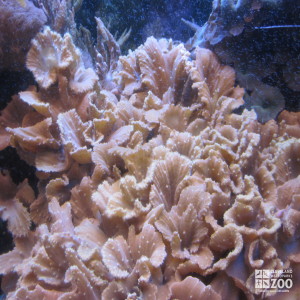Cabbage Leather Coral
[Sinularia dura]
 The cabbage leather coral is a soft coral most often found in low growing colonies attached to harder substrates such as rubble or other dead corals. The coral is characterized by broad blunt “ruffled” lobes that resemble cabbage leaves covered in fringe-like polyps, and can be found in colors ranging from brown, tan, cream, pink, purple, yellow and grey.
The cabbage leather coral is a soft coral most often found in low growing colonies attached to harder substrates such as rubble or other dead corals. The coral is characterized by broad blunt “ruffled” lobes that resemble cabbage leaves covered in fringe-like polyps, and can be found in colors ranging from brown, tan, cream, pink, purple, yellow and grey.
Location: Animals Formerly at Zoo
Share:
Range
The range of the cabbage leather coral is the Red Sea and Indo-Pacific.
Habitat
The habitat of cabbage leather coral is near shore in shallow water, flat reefs and attached to rubble-like substrates.
Conservation Status
Primary Threats
Gestation
UnknownLitter
UnknownBehavior
The Cabbage Leather Coral releases toxic terpenes (poisons that ward off encroaching corals). The Sinularia genus consists of a large number of species and subspecies, which are predominately soft corals.
Reproduction
In the wild, leather coral reproduces asexually in several ways, such as fission, budding, fragmenting and/or branch dropping. With asexual fragmentation, a section will separate from the parent colony and attach itself to another suitable location. In an aquarium environment this can be done using a scalpel or a blade by physically cutting a section off of the parent colony and transplanting it to a new location.
Wild Diet
Sinularia corals have several different methods of feeding. They are photosynthetic, having a symbiotic relationship with the zooxanthellae algae that live in their tissue. Zooxanthellae provide them with oxygen, nutrients via photosynthesis, and aid in waste removal. Cabbage Leather Coral can also use its polyps to obtain nutrients from microscopic food in the water.
Zoo Diet
Proper lighting is essential for keeping any living corals in the aquarium.
